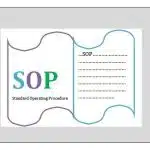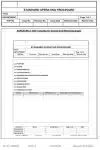Learn how to write a standard procedure SOP for calibration of FTIR apparatus (Fourier Transform Infrared) Spectrometer in quality control laboratory.
1. PURPOSE
To describes the steps for the proper calibration of the Fourier Transform Infrared (FTIR) Spectrometer to ensure accurate and reliable data for quantitative and qualitative analysis.
2. SCOPE
This SOP is applicable to all personnel who operate the FTIR spectrometer in the laboratory. It covers the calibration of the FTIR instrument, including routine maintenance, alignment, and verification procedures.
3. RESPONSIBILITIES
3.1 Laboratory Personnel: Responsible for performing the calibration procedure and ensuring it is conducted as per this SOP.
3.2 Laboratory Manager: Ensure that the FTIR spectrometer is properly calibrated and that staff are trained in the calibration process.
3.3 Technicians/Analysts: Perform the calibration procedures as outlined in this SOP and maintain records of calibration.
4. ACCOUNTABILITY
Head of the Quality Assurance Department
5. ASSOCIATED DOCUMENTS / REFERENCES
5.1 Manufacturer’s FTIR user manual.
5.2 Relevant SOPs and protocols of the laboratory.
5.3 NIST calibration standards.
6. PRECAUTIONS
6.1 Handle all calibration standards with care, ensuring that no contamination occurs.
6.2 Wear appropriate personal protective equipment (PPE) such as gloves and lab coat.
6.3 Always follow safety protocols when working with chemicals and lab equipment.
7. PROCEDURE
7.1 Materials and Equipment
7.1.1 FTIR Spectrometer
7.1.2 Calibration standards (e.g., polystyrene film, CO₂, or NIST-certified calibration standards)
7.1.3 Laboratory balance
7.1.4 Clean sample holders
7.1.5 Cleaning supplies (lint-free wipes, isopropyl alcohol, etc.)
7.1.6 Computer software for FTIR data collection
7.2 Preparation
7.2.1 Ensure that the FTIR spectrometer is powered on and operating in a stable environment (temperature and humidity controlled).
7.2.2 Confirm that the spectrometer is clean, especially the sample compartment and mirrors.
7.2.3 Verify that the sample holder is free from contamination.
7.2.4 Ensure that the optical path is clear and no obstructions are present.
7.2.5 Check the integrity of the interferometer mirrors and beam splitter.
7.2.6 Use a calibration standard such as a polystyrene film or NIST-certified calibration material as recommended by the manufacturer or lab protocol.
7.2.7 Place the calibration standard in the sample compartment, ensuring it is positioned properly according to the manufacturer’s instructions.
7.3 Calibration of the FTIR Apparatus:
7.3.1 Run a wavelength calibration using the appropriate standard (e.g., polystyrene film or CO₂).
7.3.2 Record the absorption peaks. The standard should have known characteristic peaks.
7.3.3 Compare the observed peaks with the expected values. Adjust the wavelength calibration using the software, if necessary.
7.3.4 Perform a baseline scan to check for any drifts or irregularities in the system.
7.3.5 If necessary, perform a baseline correction in the software. This step compensates for any ambient noise or baseline shifts.
7.3.6 Verify the instrument resolution by running a resolution test standard (such as polystyrene).
7.3.7 Ensure that the spectral lines are sharp and well-resolved. If the resolution is out of specification, follow the manufacturer’s instructions to recalibrate or troubleshoot.
7.3.8 Run an intensity calibration standard (e.g., a reference material such as a polystyrene film or a NIST traceable standard).
7.3.9 Ensure that the instrument response is linear across the range of interest. Adjust the instrument settings if required.
7.4 Documentation:
7.4.1 Document the date and time of the calibration, the standard used, and the operator performing the calibration.
7.4.2 Record the results of the wavelength, baseline, resolution, and intensity checks. Any adjustments made should be noted.
7.5 Maintain a calibration log that includes:
7.5.1 Date of calibration
7.5.2 Calibration standard used
7.5.3 Results of calibration checks
7.5.4 Any corrective actions or adjustments made
7.5.5 Signature of the operator performing the calibration
7.6 Troubleshooting
7.6.1 If the calibration peaks are not as expected, check for contamination in the sample compartment, misalignment of the mirrors, or errors in the standard.
7.6.2 Perform a baseline correction or check the instrument for thermal stability.
Resolution Issues: If the resolution is poor, ensure that the interferometer mirrors are clean and aligned properly.
8. DEFINITIONS AND ABBREVIATIONS
8.1 Calibration: The process of verifying that an instrument is providing accurate and reliable results, typically by comparing it with a certified standard.
8.2 FTIR: Fourier Transform Infrared
8.3 SOP: Standard Operating Procedure
8.4 NIST: National Institute of Standard and Technology
8.5 QC: Quality Control
8.6 PPE: Personal Protective Equipment
9. ANNEXES
9.1 Annex-1: Log Book for Calibration of FTIR
10. Revision History
| Version | Date | Description of Change | Reviewed By | Approved By |
| 1.0 |
Related Topics:

Abdus Sobhan Salim is professional experienced pharmacist in pharmaceuticals, author and founder of pharmabossbd.com, the first Bangladeshi pharmaceutical blogger since 2019.



